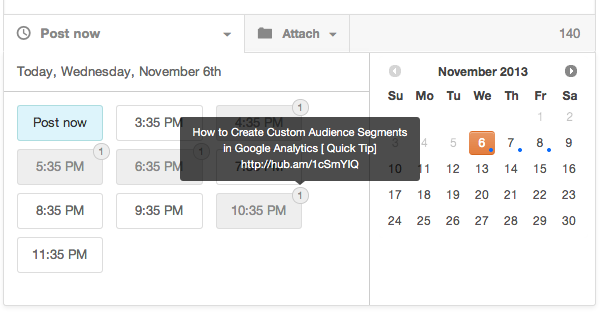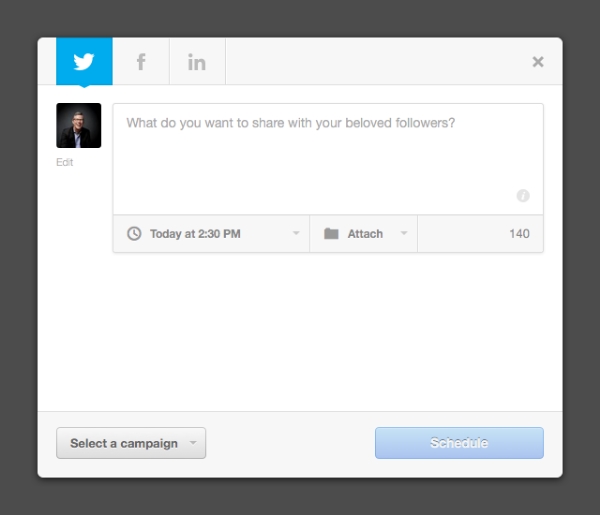 This post originally appeared on the Inbound Hub Marketing section.
This post originally appeared on the Inbound Hub Marketing section.
Social media publishing tools have always made it easy for marketers to share the same message across multiple platforms. Just select your accounts, pick a few times, hit that all-powerful ‘publish’ button, and suddenly your message is everywhere.
But is that really the best social strategy? Different content works for different networks. A message that works well on Twitter likely isn’t what’s best for Facebook or LinkedIn. And as a consumer of content, I hate seeing the same message over and over.
Today, HubSpot is launching a brand new social media publishing tool. When we set out to design it we wanted to create something that would make it easier to do the right thing: publish unique content tailored specifically for each network. We also wanted your experience of the redesign to be entirely unremarkable -- the best tools are so simple that it’s hard to imagine them working any other way. But getting to that point isn’t easy, which is why we’d like to show you how we designed, built, tested, and rebuilt something we hope will make marketers more effective.
We didn’t just want to create a flashier version of what already existed.
The old version wasn’t the best looking tool in the world, but it got the job done. Users could attach content within HubSpot, preview links used in their Facebook and LinkedIn messages, and publish to all of their different networks and accounts at once. People liked it, and they used it.
It also let people publish the same message to the same networks and accounts multiple times, which can be tedious for the people on the receiving end. It’s the social version of SPAM. Was that really the type of practice we wanted to enable?
Good inbound marketers know that different types of messages work better on different networks, and that repeating their social messages without variation over and over again leads to seriously diminishing returns. We realized that this new tool could actually be a force for good, by helping our users make the web a better, more human place. We could do that simply by encouraging marketers to publish social content the right way.
Getting to know our users revealed what was important.
Learning the routines and habits of those of you who are responsible for your company’s social media efforts -- regardless of whether you use HubSpot or not -- was an important first step. What was your day like? How was your workspace organized? What did and didn't you have time for? We visited a few marketers to help answer these questions.
It was clear that, with marketers’ increasing responsibilities, most of you don’t have much time to devote to social marketing at all. The people we interviewed typically spent about 20 minutes every morning setting up their messages for the day, and then maybe they’d check in periodically to see what was working and respond to a few messages. The real challenge was in finding content that was worth sharing. And they needed to get more mileage out of the good content they had.
We also noticed that keeping track of what content to publish when is a big challenge for every social marketer. Coordinating multiple campaigns across multiple networks and accounts -- and doing it effectively -- was worth whatever effort it required. Here is how one HubSpot customer keeps track of his social media schedule:
We saw many variations on this type of schedule, all requiring a considerable effort to maintain. This told us that knowing when different messages are scheduled to publish is a big deal for social marketers, and that even the simplest feature to help provide that view would save you valuable time.
Ugly beginnings helped frame the discussion.
Once we understood how the new tool could help people solve a real problem they already had, we knew how to at least get started with the design.
This is our first version:
Looking back, it’s easy to see how much further we had to go. There’s no guidance, no obvious “start here!” component that draws the eyes, and no one was entirely sure what the different elements meant. But despite its (now) obvious deficiencies, it did get one thing right: It took what we learned from our research and put it all together in one place.
With all of the important features now focused in one design, we at least had something to work with. From here, we were able to prioritize features and remove anything that our users thought was superfluous. We had something to test our assumptions against.
Testing refined what worked, but it also sent us back to the drawing board.
As always, testing provided moments of affirmation and frustration.
Our initial testing process involved asking questions while users navigated through a series of clickable mockups that demonstrated a typical compose flow. This helped us discover what people found to be useful, what they didn’t understand, and how the new tool might fit into their daily routine. People loved that they would be able to write unique messages for different networks and that they could see what content was already scheduled, but few were able to notice those features without being told explicitly how to use them.
After a series of revisions, this is what we came up with next:
All of a sudden, it’s starting to look a little more focused and welcoming. It’s now clear which options are associated with your message and which are for the set of messages. We felt more comfortable with this design, so we started to build.
One feature that represented a big opportunity was the schedule drop-down. Knowing when to say something is just as important as knowing what to say. After drafting many different versions, we settled on a time-selection feature that tells users what’s already scheduled without getting in the way of the primary task of selecting a time to post.
Our next round of testing was a little different. We spent less time asking questions and more time observing. Now that we had live code to test, we were able to see how users interacted with the tool as they went about their natural flow. This showed us how people used it in different ways, and how we needed to account for those differences.
For instance, we noticed people didn’t always select an account before trying to publish, and a few testers asked to be able to see which posts were already scheduled, missing the fact that this feature was already available to them. Based on this feedback, we worked to make those features more obvious, and this is what we ended up with:
This is just one part of an exciting upgrade in the works.
While we’ve still got more work to do, we now have something that sets the tone for the improvement of HubSpot’s social tools to come. The challenge is to create tools that don’t just make it easier to publish social content, but to be a good inbound marketer. A better citizen of the web. Because it’s not just about producing more content anymore. With this new tool -- and the new tools that will follow -- HubSpot users can publish better content more quickly, resulting in a more happily engaged audience, and a better web for us all.
Next, we’ll be working on building better tools that give you everything you need to make the most out of the little time you have for managing your social media. Tools for organizing your messages and campaigns, analytics to see what’s working, tips for writing even more effective messages, and suggestions as to when to post them.
So, what do you think?
If you’re a HubSpot customer, this new update is available to you now. If you’re not a HubSpot customer yet, you can see it for yourself through our free trial. See a way to make things better? Let us know by posting a comment below or on our customer beta forum. You can also help us refine future product features as a usability tester -- whether you’re a HubSpot customer or non-customer.
Hopefully this has been an insightful view into how we’re making the practice of inbound marketing a better, more productive experience. It’s an experience that both HubSpot and its customers are heavily invested in, and it’s that active partnership that is driving the improvement of our tools. Tools that make it easier to do marketing the right way.











